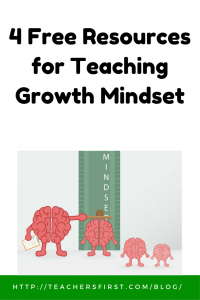“Whether you think you can, or think you can’t — you’re right.”
Henry Ford
September 13 is Positive Thinking Day. Consider it to be an excellent time to stop and think about how to develop positive thinking and attitudes in our students. One well-known method to promote positive thinking is through growth mindset.
Growth mindset, based on the inspiring work of Carol Dweck, continues to pick up steam in the education community more than five years after her first presentation of the theory. Dweck’s theory states that through the use of specific strategies intelligence can be developed similar to training a muscle to increase strength and resilience. She specifically points out attributes of a fixed mindset and those of a growth mindset as displayed in this printable chart.
 Unfortunately, misunderstanding of growth mindset concepts has led to what Dweck has coined as “a false growth mindset”. This confusion leads some to believe that growth mindset is the use of praise and compliments. Nothing is farther from the truth, in fact, Dweck mentions in the same 2016 interview that “The mindset ideas were developed as a counter to the self-esteem movement of blanketing everyone with praise, whether deserved or not. To find out that teachers were using it, in the same way, was of great concern to me. The whole idea of growth-mindset praise is to focus on the learning process. When you focus on effort, [you have to] show how effort created learning progress or success.”
Unfortunately, misunderstanding of growth mindset concepts has led to what Dweck has coined as “a false growth mindset”. This confusion leads some to believe that growth mindset is the use of praise and compliments. Nothing is farther from the truth, in fact, Dweck mentions in the same 2016 interview that “The mindset ideas were developed as a counter to the self-esteem movement of blanketing everyone with praise, whether deserved or not. To find out that teachers were using it, in the same way, was of great concern to me. The whole idea of growth-mindset praise is to focus on the learning process. When you focus on effort, [you have to] show how effort created learning progress or success.”
Conduct a quick Google search for growth mindset or growth mindset lessons to find many different resources and articles. It’s hard to know right away if these resources live up to the standards of Carol Dweek’s growth mindset criteria. The following sites provide free lessons, videos, and more for learning about and teaching proper growth mindset techniques in your classroom.
- Class Dojo (Grades K-8) – Class Dojo and Stanford’s PERT Research Center offer an animated video series teaching growth mindset through short videos and discussion activities. Titles include The Incredible Power of Yet and The Magic of Mistakes. In addition to its classroom resources, this site includes questions to share with parents for use with at-home discussions.
- Mindset Kit (Grades K-12) – This site features online learning tools for teachers and parents. The teacher portion of the site offers lessons on the concepts of a growth mindset, how to teach growth mindset, and use of assessments that promote a growth mindset. The parent section includes lessons for understanding the importance of and developing a growth mindset through proper forms of praise at home. Schools will appreciate the course created just for educator teams.
- YouCubed Growth Mindset Resources (Grades K-12) – Here you will find a range of resources including articles, strategy cards, video, and a poster for classroom use. Most of these resources relate specifically to math classes. Be sure to check out the mindset cards; they include many ideas for implementing growth mindset in classrooms. Print and keep the questions and task/lesson design ideas handy as you lesson plan and consider guiding questions during lessons.
- With Math I Can (Grades K-12) – This is an inclusive site with many resources starting with an introduction to growth mindset and with progression toward professional development for educators. One of my favorite parts is the lessons for teaching growth mindset with Legos. Although very simple, these experiences demonstrate the power of connecting learning to student’s prior knowledge then increasing learning through specific and focused questioning.
Last September I wrote about how to use three-minute journals in a blog about growth mindset. Some other ideas implemented easily into any classroom include:
- Explore and encourage multiple strategies – highlighting that there may be multiple ways to arrive at an answer allows students to feel validated in their thinking. Students learn to persist when encouraged to follow their train of thought instead of having to follow one problem-solving method.
- Don’t be afraid to challenge your students –Know how to provide lessons that challenge your students to think beyond what they know and that provide some degree of frustration. Knowing how to face challenges and move beyond frustration is an integral part of developing a growth mindset.
- Demonstrate your own growth thinking – share stories and examples of your learning with your students. Let them see that learning doesn’t just take place in a classroom, it continues throughout life.
- Try to understand student thinking – at first a student response may not make sense. Explore the response further by asking him to explain how he arrived at that answer. This not only helps you to understand, but it also helps your student think through their thought process.
- Remember to use wait time – this may be one of the hardest things for some teachers, but give students time. This lets students know that you expect more information and also helps to build grit. Instead of moving past struggles, embrace them. Take the time to explore struggles and what it takes to be successful.
Are you explicitly teaching growth mindset in your classroom? What strategies have you found that work the best? We would love to hear from you in the comments below.

